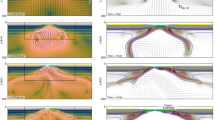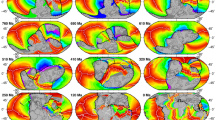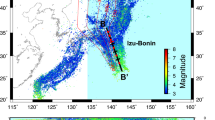Abstract
Reactivation of structures inherited from previous collisional or rifting events, especially lithospheric-scale faults, is a major feature of plate tectonics. Its expression ranges from continental break-up along ancient collisional belts1,2 to linear arrays of intraplate magmatism and seismicity3,4. Here we use multiscale numerical models to show that this reactivation can result from an anisotropic mechanical behaviour of the lithospheric mantle due to an inherited preferred orientation of olivine crystals. We explicitly consider an evolving anisotropic viscosity controlled by the orientation of olivine crystals in the mantle. We find that strain is localized in domains where shear stresses on the inherited mantle fabric are high, and that this leads to shearing parallel to the inherited fabric. During rifting, structural reactivation induced by anisotropy results in oblique extension, followed by either normal extension or failure. Our results suggest that anisotropic viscosity in the lithospheric mantle controls the location and orientation of intraplate deformation zones that may evolve into new plate boundaries, and causes long-lived lithospheric-scale wrench faults, contributing to the toroidal component of plate motions on Earth.
This is a preview of subscription content, access via your institution
Access options
Subscribe to this journal
Receive 12 print issues and online access
$259.00 per year
only $21.58 per issue
Buy this article
- Purchase on Springer Link
- Instant access to full article PDF
Prices may be subject to local taxes which are calculated during checkout



Similar content being viewed by others
References
Wilson, J. T. Did the Atlantic close and then re-open? Nature 211, 676–681 (1966).
Vauchez, A., Barruol, G. & Tommasi, A. Why do continents break up parallel to ancient orogenic belts? Terra Nova 9, 62–66 (1997).
Sykes, L. R. Intraplate seismicity, reactivation of preexisting zones of weakness, alkaline magmatism, and other tectonism postdating continental fragmentation. Rev. Geophys. Space Phys. 13, 621–688 (1978).
Zoback, M. D. et al. Recurrent intraplate tectonism in the New Madrid Seismic Zone. Science 209, 971–976 (1980).
Durham, W. B. & Goetze, G. Plastic flow of oriented single crystals of olivine. 1. Mechanical data. J. Geophys. Res. 82, 5737–5753 (1977).
Bai, Q., Mackwell, S. J. & Kohlstedt, D. L. High-temperature creep of olivine single crystals. 1. Mechanical results for buffered samples. J. Geophys. Res. 96, 2441–2463 (1991).
Tommasi, A., Mainprice, D., Canova, G. & Chastel, Y. Viscoplastic self-consistent and equilibrium-based modelling of olivine lattice preferred orientations. Implications for upper mantle seismic anisotropy. J. Geophys. Res. 105, 7893–7908 (2000).
Wuestefeld, A., Barruol, G. & Bokelmann, G. Shear-wave splitting database; available at <http://www.gm.univ-montp2.fr/splitting/>.
Hill, R. A theory of yielding and plastic flow of anisotropic metals. Proc. R. Soc. Lond. A 193, 281–297 (1948).
Christensen, U. Some geodynamical effects of anisotropic viscosity. Geophys. J. R. Astron. Soc. 91, 711–736 (1987).
Honda, S. Strong anisotropic flow in a finely layered asthenosphere. Geophys. Res. Lett. 128, 1454–1457 (1986).
Lev, E. & Hager, B. H. Rayleigh–Taylor instabilities with anisotropic lithospheric viscosity. Geophys. J. Int. 173, 806–814 (2008).
Tommasi, A. & Vauchez, A. Continental rifting parallel to ancient collisional belts: An effect of the mechanical anisotropy of the lithospheric mantle. Earth Planet. Sci. Lett. 185, 199–210 (2001).
Lebensohn, R. A. & Tomé, C. N. A self-consistent anisotropic approach for the simulation of plastic deformation and texture development of polycrystals: Application to zirconion alloys. Acta Metall. Mater. 41, 2611–2624 (1993).
Tommasi, A., Tikoff, B. & Vauchez, A. Upper mantle tectonics: Three-dimensional deformation, olivine crystallographic fabrics and seismic properties. Earth Planet. Sci. Lett. 168, 173–186 (1999).
Vauchez, A. & Tommasi, A. in Intraplate Strike-Slip Deformation Belts (eds Storti, F., Holdsworth, R. E. & Salvini, F.) 15–24 (Special Publication, Vol. 210, Geological Society of London, 2003).
Vauchez, A. & Nicolas, A. Mountain building: Strike-parallel displacements and mantle anisotropy. Tectonophysics 185, 183–201 (1991).
Braun, J. et al. A simple parameterization of strain localization in the ductile regime. J. Geophys. Res. 104, 25167–25181 (1999).
Regenauer-Lieb, K. & Yuen, D. A. Positive feedback of interacting ductile faults from coupling of equation of state, rheology and thermal-mechanics. Phys. Earth Planet. Int. 142, 113–135 (2004).
Bercovici, D. & Ricard, Y. Tectonic plate generation and two-phase damage: Void growth versus grain size reduction. J. Geophys. Res. 110, B03401 (2005).
Montési, L. G. J. & Zuber, M. T. A unified description of localization for application to large-scale tectonics. J. Geophys. Res. 107, 2045 (2002).
Bosworth, W. & Strecker, M. R. Stress field changes in the Afro-Arabian rift system during the Miocene to Recent period. Tectonophysics 278, 47–62 (1997).
Geoffroy, L., Bergerat, F. & Angelier, J. Tectonic evolution of the Greenland–Scotland Ridge during the Paleogene; new constraints. Geology 22, 653–656 (1994).
Schumacher, M. E. Upper Rhine Graben: Role of preexisting structures during rift evolution. Tectonics 21, 1–17 (2002).
Powell, C. M. A., Roots, S. R. & Veewers, J. J. Pre-breakup continental extension in East Gondwanaland and the early opening of the eastern Indian Ocean. Tectonophysics 155, 261–283 (1988).
Keppie, J. D. in Terranes in the Circum-Atlantic Paleozoic Orogens (ed. Dallmeyer, R. D.) 159–192 (Special Paper, Vol. 230, Geological Society of America, 1989).
Herrmann, R. B. & Canas, J.-A. Focal mechanism studies in the New Madrid seismic zone. Bull. Seismol. Soc. Am. 68, 1095–1102 (1978).
Mazabraud, Y., Bethoux, N., Guilbert, J. & Bellier, O. Evidence for short-scale stress field variations within intraplate central-western France. Geophys. J. Int. 160, 161–178 (2005).
Barruol, G., Silver, P. G. & Vauchez, A. Seismic anisotropy in the eastern United States: Deep structure of a complex continental plate. J. Geophys. Res. 102, 8329–8348 (1997).
Judenherc, S., Granet, M., Brun, J.-P. & Poupinet, G. The Hercynian collision in the Armorican Massif; evidence of different lithospheric domains inferred from seismic tomography and anisotropy. Bull. Soc. Geol. Fr. 174, 45–57 (2003).
Lithgow-Bertelloni, C., Richards, M., Ricard, Y., O’Connell, R. J. & Engebretson, D. C. Toroidal–poloidal partitioning of plate motions since 120 Ma. Geophys. Res. Lett. 20, 375–378 (1993).
Bernacki, M., Chastel, Y., Coupez, T. & Logé, R. Level set framework for the numerical modelling of primary recrystallization in polycrystalline materials. Scripta Mater. 58, 1129–1132 (2008).
Acknowledgements
This study was partially funded by the programme Action Marges of the Institut National des Sciences de l’Univers, Centre National de la Recherche Scientifique (INSU-CNRS), France. Collaboration with J.S. was supported by a CNRS-CONICET cooperation program. M.K. benefited from a PhD scholarship from the Ministère de la Recherche et de l’Enseignement Supérieur, France.
Author information
Authors and Affiliations
Contributions
This work is the outcome of a study on the effect of olivine fabrics on the mechanical behaviour of the continental lithosphere started by A.V. and A.T. M.K. ran all simulations as part of his Ph.D. under the supervision of A.T. and R.L. J.W.S. performed the coupling between the VPSC and the FEM codes. C.T. assisted in the analysis of the modelled flow fields.
Corresponding author
Supplementary information
Supplementary Fig. S1
Supplementary Information (PDF 697 kb)
Rights and permissions
About this article
Cite this article
Tommasi, A., Knoll, M., Vauchez, A. et al. Structural reactivation in plate tectonics controlled by olivine crystal anisotropy. Nature Geosci 2, 423–427 (2009). https://doi.org/10.1038/ngeo528
Received:
Accepted:
Published:
Issue Date:
DOI: https://doi.org/10.1038/ngeo528
This article is cited by
-
Grain-size-evolution controls on lithospheric weakening during continental rifting
Nature Geoscience (2022)
-
The most frequent interfaces in olivine aggregates: the GBCD and its importance for grain boundary related processes
Contributions to Mineralogy and Petrology (2015)
-
3D-FEM modeling of the microscopic stress field of forsterite aggregate under hydrostatic pressure: Significance of the crystal orientation
Science China Earth Sciences (2014)
-
Laboratory measurements of the viscous anisotropy of olivine aggregates
Nature (2012)
-
From rifting to oceanic spreading in the Gulf of Aden: a synthesis
Arabian Journal of Geosciences (2012)



